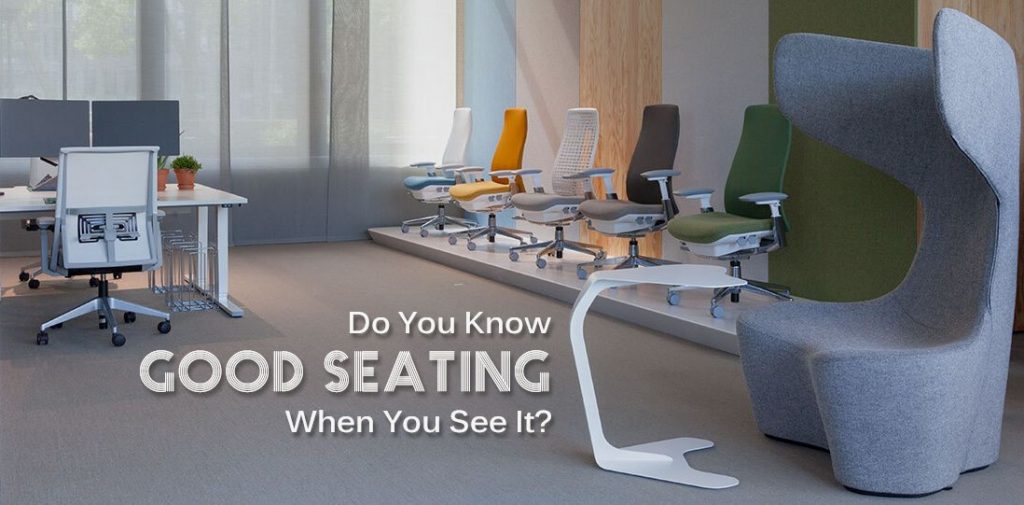Have a seat. Pull up a chair. Take a load off. Don’t just sit there … hold on to your seat! We make hundreds of references to sitting and seating in our casual conversations. Shouldn’t you make sure you have the best seats available in your workplace for you, your coworkers, and your guests?
But where do you start? Do you even know how to identify good seating? When it comes to modern seating, there are so many different mechanisms and components you could specify that they would fill an encyclopedia. However, everything you need to worry about can be summarized in three simple points.
What to Look for in Good Seating
1. Does your seating support and adjust to your body?
Comfort is one of the first things people consider when they pick a chair and, if a chair isn’t comfortable, it’s the only thing they remember. Despite all the advancements that have occurred in seating technology, most people never take the time to learn what all the levers and knobs do on their chairs. That means the best chairs are the ones that are intuitive and adaptive without the need for manual adjustment by the user.
Task seating is the main seating type that people think of when it comes to support and body contouring. Fern by Haworth is a research-driven task chair that accommodates the diverse working population with new levels of all-day comfort, regardless of size, posture, or work mode. As you move or change posture, Fern works with you, not against you, so you can stay focused on the tasks at hand. With no hard outer frame, Fern has a soft and pliable edge that won’t jar you or limit your movement.
A lesser considered seating type is stools. You might not think about body movement here, but Haworth’s Tilt stool was designed specifically for that purpose. Tilt moves with you. Many stools adjust from standing height to a low stool and remain active throughout the day. With Tilt, you can also change postures easily by leaning forward or back, side to side so you can remain engaged in your activity and be supported.
Before you dive into tools and features, the best thing you can do in selecting a chair is try it out. Visit our showroom or schedule a demo in your workplace to see if the chair you like likes you back.
2. Are there accommodations for the ergonomic needs of all users?
Unless you intend your users to sit for a couple minutes and then leave, you should give some thought to ergonomics. Don’t be fooled or overwhelmed by this concept; ergonomics, also known as human factors, simply refers to designs that focus on efficiency and comfort in the working environment. For example, Haworth’s Very Side and Seminar chair provides intuitive recline, ensuring user weight is absorbed and distributed to provide natural support. Its side-to side torsional flex allows the backrest to follow the user as they move, increasing mobility and comfort when reaching sideways for objects. And, as with all Haworth seating, it’s warranted for 24/7 multiple shift use by persons up to 325 lbs.
So, look at your seating and ask yourself: Are all my users able to easily and comfortably sit down, complete whatever actions they wish to complete, and then get back up? If so, you’re winning the ergonomics game for seating.
3. Does the seat fit the task at hand?
You’ve heard the phrase “jack of all trades, master of none.” This can easily be applied to seating because one chair can’t do it all. It’s important to consider the tasks that people will be doing while they sit in any chair to ensure that their movements are not hindered by it nor is the chair likely to be damaged because of improper usage. When choosing seating for a range of uses, it can be helpful to select pieces that are part of a collection so that materials and finishes are complementary.
An example of this is the Gigi II by Janus et Cie. This indoor/outdoor chair has solutions for office, home, and public spaces. It is available as armchairs, lounges, and stools to comfortably accommodate the varied needs of dining, relaxing, meetings, and casual conversations. Its multiple finishes make it easy to coordinate with other furnishings, and the weave of the recyclable resin wicker fiber is smooth, strong, completely waterproof, and resistant to UV rays, which means Gigi II can withstand the elements and heavy use in any setting.
For the hospital, Haworth Health’s Gates collection features a comprehensive suite of guest and tandem chairs for the lobby and recliners and sleepers for the patient room. It also includes coordinating casegood pieces. In addition to common healthcare features like horizontal cleanouts and antimicrobial materials, Gates seating has field replaceable footrests, seats, backs, levers, and armcaps to make ownership easier for facility professionals.
No matter what your users need to do, we’ve got a chair for that.
Still have questions?
If you still aren’t sure you have the right seating for your spaces, let us schedule a complementary seating survey. Contact your Wittigs representative to find solutions that will fit all your seating expectations.
